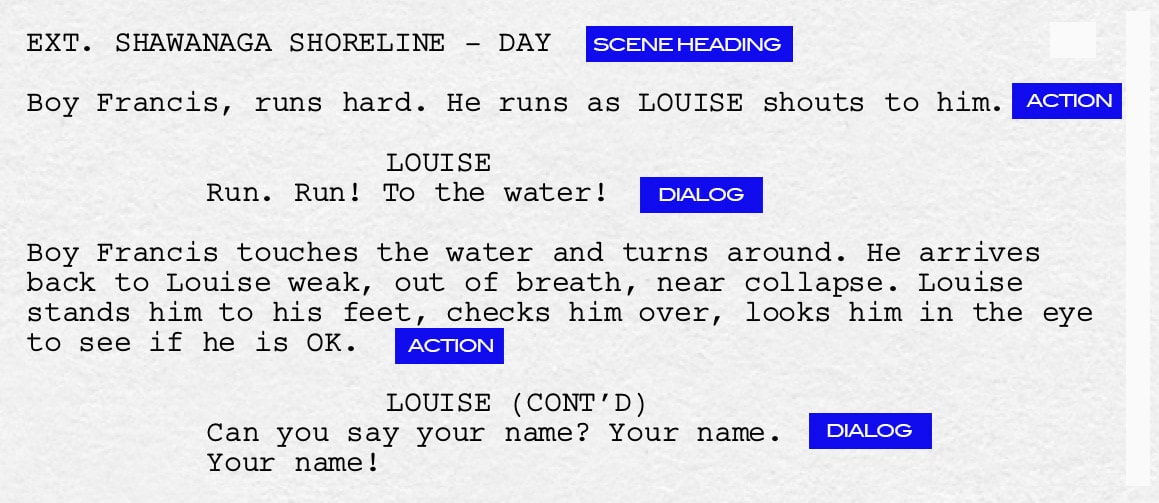
A naked slugline is a scene heading that has no action line(s) after it. Format Tells All.” I’m also really impressed by Christopher Riley’s book, “The.īy Trevor Mayes | | Formatting, Modern Craft, WritingWhat’s a naked slugline? Actually, even before that - what’s a slugline? A slugline is just another word for a scene heading. Format” and his books, “The Screenwriter’s Bible” and “Dr. But what happens when you want.īy Trevor Mayes | | Formatting, Modern Craft, Text Messaging, WritingSuperman, I defy you! I’m a big fan of David Trottier, AKA “Dr. in a scene heading, it means “exterior.” That much is straightforward. in a scene heading, it means “interior” and when you use EXT. Sure You’re Using Them Correctly?īy Trevor Mayes | | Formatting, Modern Craft, Proofreading, WritingThis one’s easy, right? Not so fast. SAME TIME SAME (sometimes written as SAME TIME) means that the. They are not the same thing and have very different uses. The writer will use SAME when they mean CONTINUOUS.
SLUGLINE VS SCENE HEADING HOW TO
Thus, when learning how to do secondary slug lines in a screenplay, make sure that you’re using your master scene heading for the primary scene and the secondary slug lines for any subsequent area within the main master scene before you move to another scene.Scene Headings: SAME does not equal CONTINUOUSīy Trevor Mayes | | Formatting, Modern Craft, Scene Headings, Screenwriting BasicsI’ve been seeing this mistake a lot lately in the scripts I’ve been proofreading. Once your screenplay scene moved out of San Francisco to another area or neighborhood, you would add a new master heading that would dictate the new location. STREETS OF SAN FRANCISCO – DAY as your primary or master slug whereas your secondary slug lines might include any of the following locations AN INTERSECTION, GOLDEN GATE BRIDGE, A CABLE CAR, etc. If you’re wondering how to do secondary slug lines in a screenplay that is outlining a police chase in San Francisco. The primary difference between a master slugline and a secondary slug line or mini-slug is that the use of a secondary slug provides an additional element of describing the location of the scene in greater detail.Įspecially in a situation where there will be several working camera setups for a particular location, the secondary scene headings can become very helpful. Secondary slug lines are also sometimes referred to as a mini-slug. LOBBY – HOTEL – DAY would be the preferred method when looking at how to do secondary slug lines in a screenplay. HOTEL LOBBY – DAY or the screenwriter might just use a single word within the scene LOBBY to denote the secondary location. The secondary slug line represents the secondary location within the hotel such that you might have a secondary scene heading that appears like INT. HOTEL – DAY, such that “HOTEL” is the primary location.

For example, the master scene heading might be INT. They’re likely to organize the shooting schedule such that the EXT scenes are filmed together as one group and the INT scenes are filmed together as another group.Ī master scene heading identifies the master or preliminary location of a scene. DAY/NIGHT – tells the loaders what to pack, similar to the INT/EXT.Īdditionally, when the director and the AD work together to formulate the shot list.LOCATION – assists in the creation of a shooting schedule.INT/EXT – tells those loading the grip truck what kind of equipment they should be packing.

While you might not realize how much information such a simple line of text can provide for an entire working production crew. The scene header or slug line will typically looks something like. And provide important information regarding production setup for the camera crew. Sluglines are scene headings that are incorporated into a screenplay to orient the reader. As they’re just navigating basic screenplay and script formatting. In fact, learning how to do secondary slug lines in a screenplay is something that many aspiring screenwriters will bring up early in their careers. And when to include them in their screenplays. Many aspiring screenwriters are at a loss of exactly how to write them. But despite the importance of these very basic headings.

As it denotes the need for a particular camera setup during production setup. The use of scene headers, also known as slug lines, is very important in screenwriting. How to do Secondary Slug Lines in a Screenplay


 0 kommentar(er)
0 kommentar(er)
